Focus farmer: Pak Ma'mur
Profile of a dairy business - July 2019.
“The journey of surviving in the dairy business is not easy and there are times where additional support and guidance is needed to develop a better business”Pak Ma'mur
Pak Ma'mur began dairy farming in 1999 which was an interest that formed when helping his parents with the livestock business. He was able to take over the dairy farm from his parents and enjoys caring for his cows. From 1999, the farm grew from 2 to 10 head of cattle in 2004 but then later sold most of these cows for household needs. With fewer cows, the farm was less profitable and between 2004-2006 Pak Ma'mur and his wife, Ibu Eneng switched professions, to a KPS paramedic personnel in Bogor and an entrepreneur selling building equipment.
“Because we had a passion for farming, I stopped working as a paramedic in KPS Bogor and focused on developing our dairy business,” said Pak Ma'mur.
At the end of 2006, Pak Ma'Mur started farming again with three cows ready to AI, and then in 2008 obtained APBN (Government Budget) to have one more cow. By 2013, Pak Ma'mur had increased his herd size to 14 head and moved to a larger farm in the same village, but closer to Mount Salak and formed a farmer group called Kelompok Mandiri Sejahtera. In 2019 the population owned by Pak Ma'mur is 41 head.
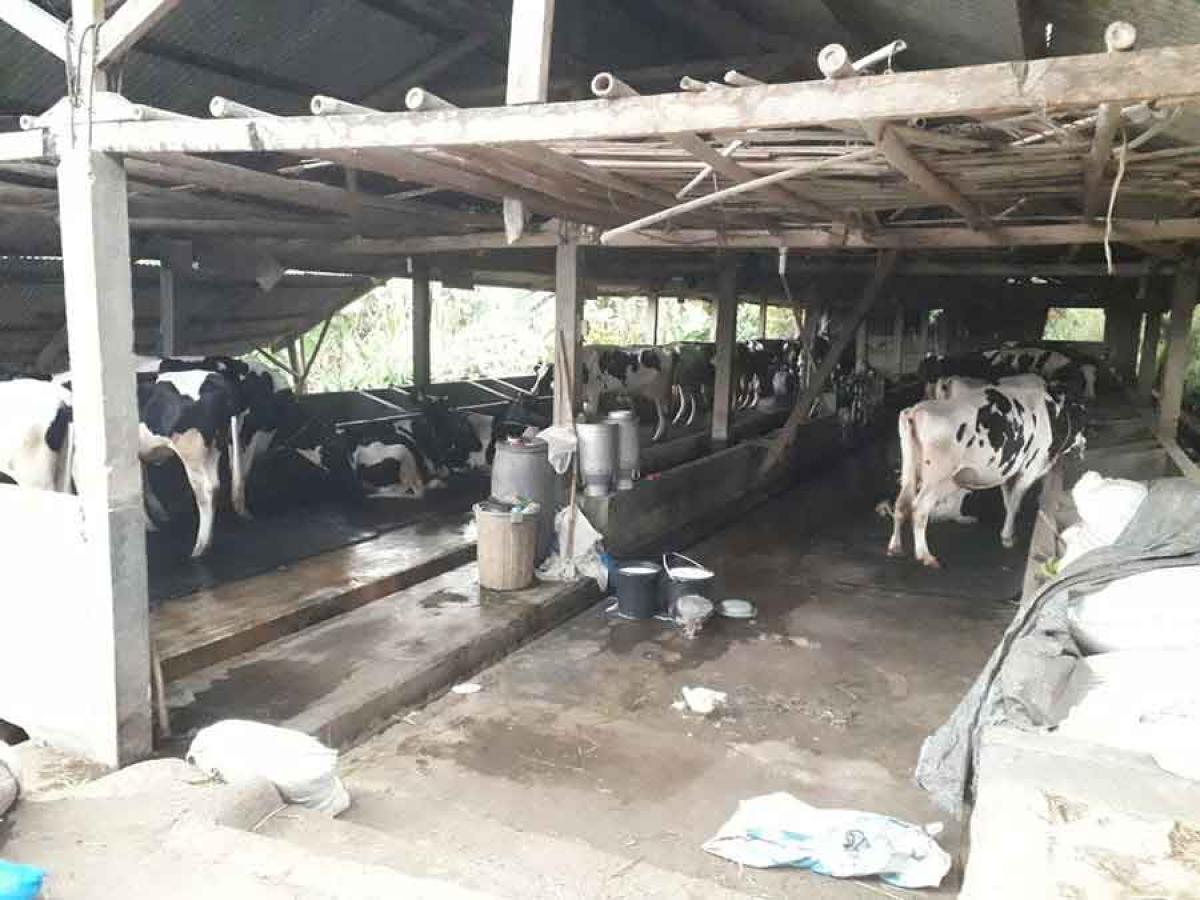
Pak Ma’mur and Ibu Eneng’s cattle shed.
- Herd size: 41
- Number of milking cows: 21
- Dry cows: 1
- Calves (0-4 months): 9
- Heifers: 10
- Average milk production: (litres/day/cow): 12
- Current milk fat: 3.9%
- Current milk protein/total solids: 3.2%
- Milk price/L: Rp. 5,000
- Farmer Group: Mandiri Sejahtera, Cijeruk, Bogor
Although the dairy farm business has successfully grown, Pak Ma'mur encounters some challenges upstream and downstream from the farm, impacting on the growth of the business. This includes limited ability to sell and market his milk at a higher price, as well as sourcing good quality inputs such as feed. In addition, there are challenges with the capacity of employed labour to undertake farm activities. In future Pak Maʼmur and Ibu Eneng hope to improve the business to better utilise forages on their land, improve management of livestock, as well as processing and marketing of dairy products with plans to build an agro-tourism facility in the Tajur Halang village.
Although these challenges exist, they are interested in accessing additional information and training to assist develop the farm. Pak Ma'mur and Ibu Eneng are motivated to participate in the IndoDairy activities, through the Focus Farm as they both are willing to learn how to better manage their business to achieve their future goals.
Update - October 2019.
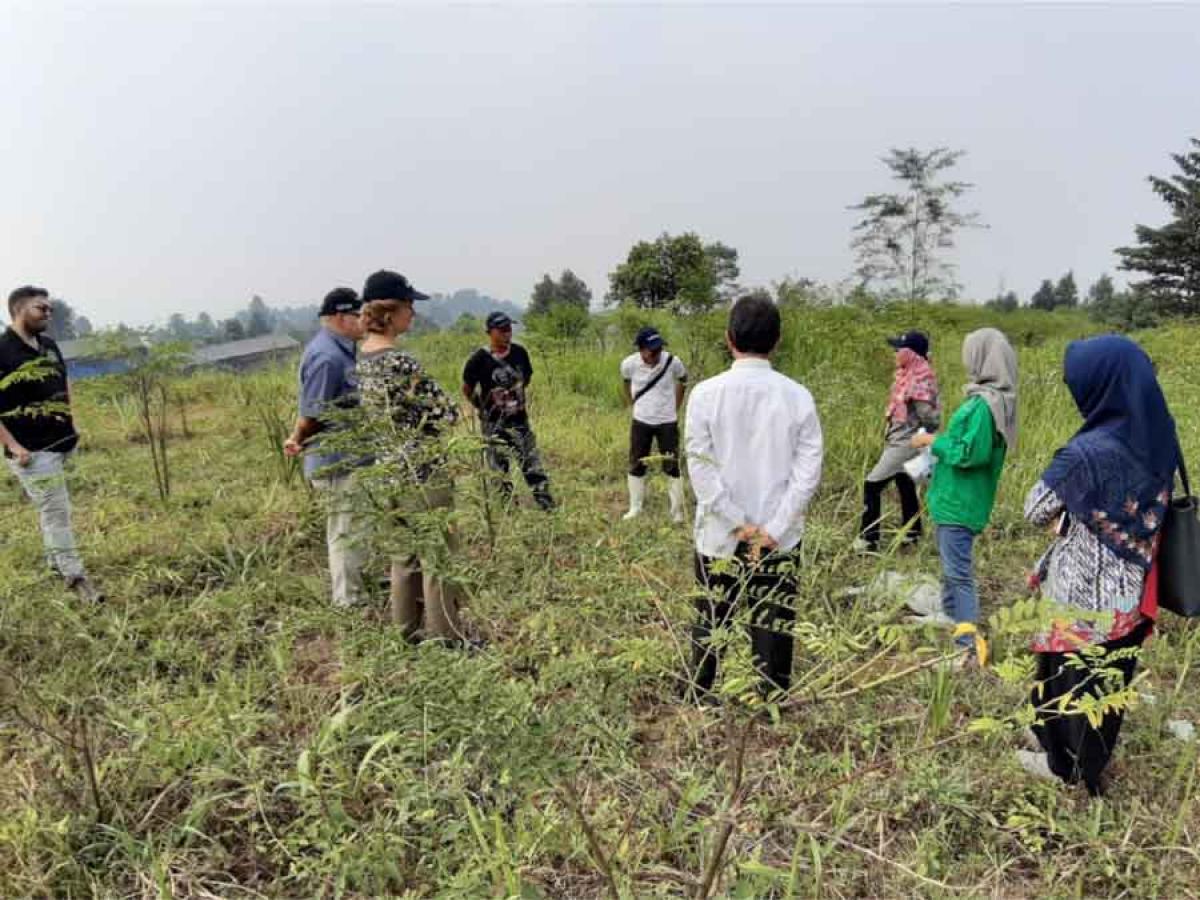
Block of land rented by Pak Ma'mur in Cijeruk who is growing Odot and Indigoferra. The paddock will be a focus of improvement during Focus Farm activities.
Two Focus Farm meetings were held on 20 August and 8 October 2019 at the Pak Ma'mur's farm since the commencement of the Focus Farm activity in Cijeruk in June. Each meeting was attended by a support group consisting of advisors and farmers. Advisors have been selected based on their technical expertise to help support the Focus Farmer. Support farmers are neighbouring farmers chosen by Pak Ma'mur to provide input and share their experience in dairy farming.
During the first meeting, the goals of the farm were described by Pak Ma'mur and Ibu Eneng and discussed with the Focus Farm support group.
The goals of Pak Ma'mur are to:
- Build an Agro Tourism facility as a way of utilizing owned land assets and increasing sales of dairy products (long term goal) and;
- Increasing milk production from 10 litres to 20 litres/cow/day.
As a priority for the advisory group meetings it was decided to focus on improving forage production and feeding on the farm as a means to increase milk production. During the first meeting, the land available was visited and soil samples were taken for analysis to identify the best way to make improvements. Nutrition samples were also analysed for forages and concentrate. The results of the analysis were discussed at the second meeting. The results showed that the organic matter (carbon) as well as phosphorus and potassium were very low. Also the paddocks sampled had a low ph of 5.2 and 4.9, indicating the soils are quite acidic. Analysis of the concentrates showed they had a low protein content of only 9% crude protein.
With this information the recommendations of the Focus Farm support group are to:
- Improve the soil nutrient content for nitrogen, phosphorus and potassium by applying compost and inorganic fertilisers, as well increase soil pH by applying lime (calcium carbonate).
- Trial some forage varities such as Elephant Grass and Biograss with different urea applications, as well as legume varieties to help increas protein content in the diet.
Pak Ma'mur has now started to prepare his land with compost and lime to trial the different forages, which will be sown at the end of October to monitor the growth and performance of different forage varieties. Pak Ma'mur is looking forward to undertaking these trials on his farm, as well as gaining new knowledge about managing his land with different fertiliser applications.
Update - February 2020.
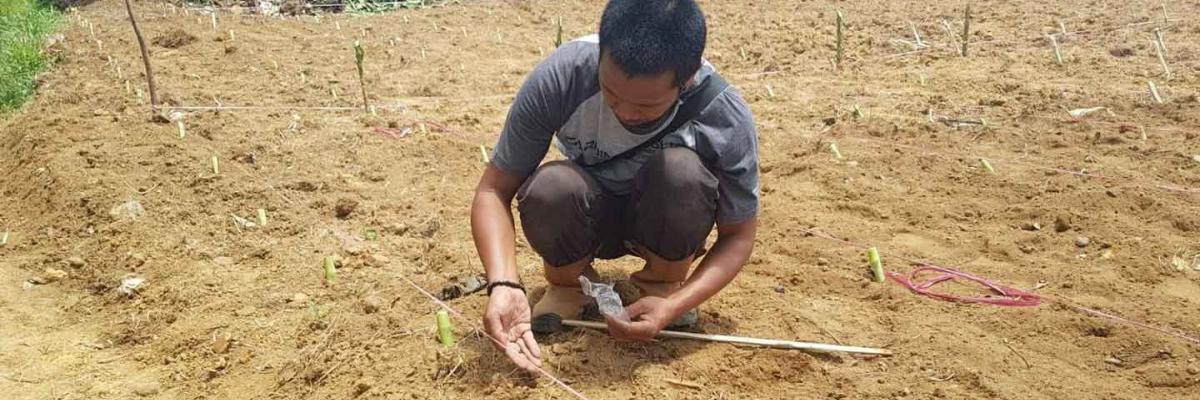
Pak Ma'mur planting Clitoria ternatea seeds between rows of biograss cuttings as part of the forage plot trial on his farm.
As of February 2020, Pak Ma'mur's current farming conditions are stable with well-met forage and concentrate needs. In the last few months leading up to the rainy season there was a shortage of feed because of difficulty sourcing grass due to the lack of rainfall. Currently, Pak Ma'mur's herd size is 36 with 11 milking cows. During the Focus Farm activities, there was a decline in the total number of cows on the farm because some were sold to support household needs and some were sick.
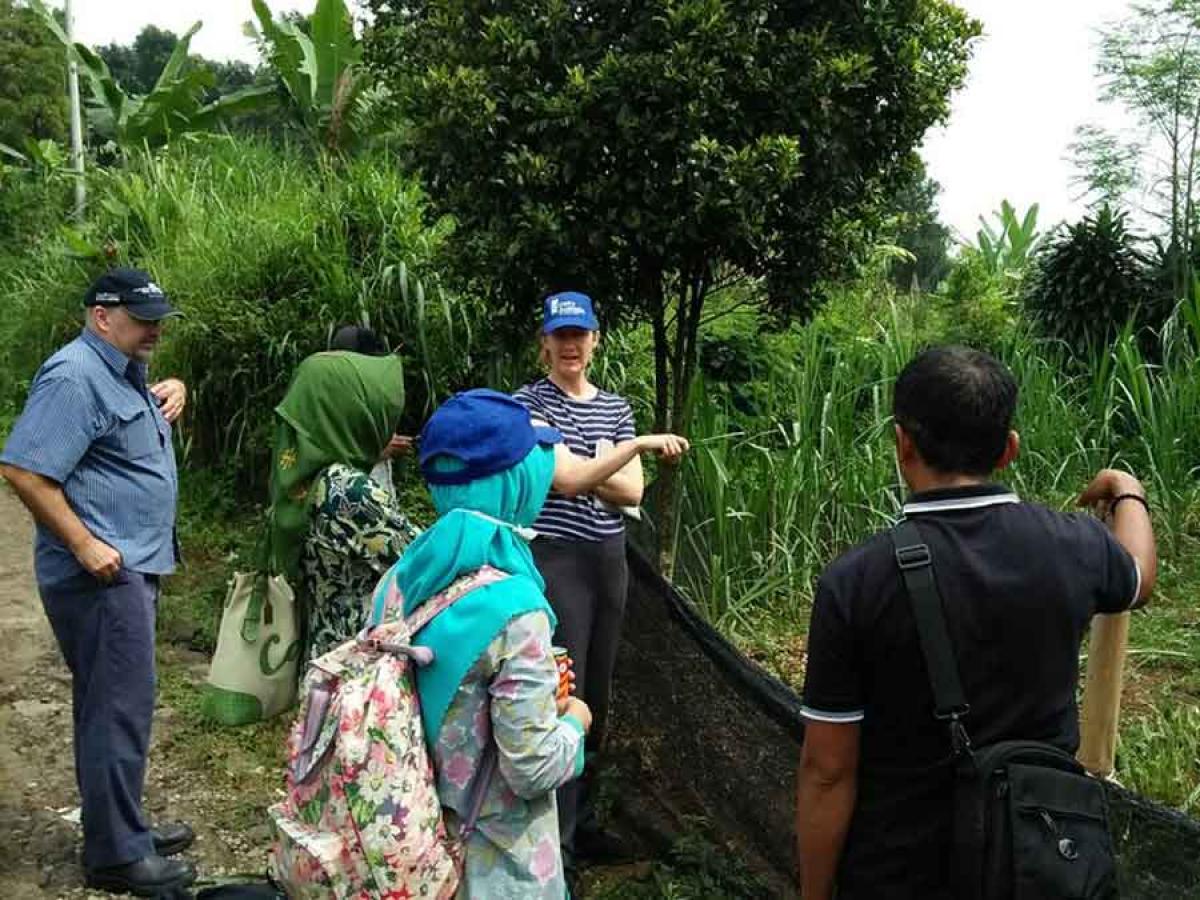
The Focus Farm advisory group inspecting the forage plot trial. It was observed that elephant grass had higher yield than biograss after 2 months of growth.
- Herd size: 36
- Number of milking cows: 11
- Dry cows: 4
- Male calves 1 year old: 10
- Heifers: 11
- Average milk production: (litres/day/cow): 10
- Current milk fat: 4.3%
- Current milk protein/total solids: 3.5%
- Milk price/L: Rp. 5,000
- Farmer Group: Mandiri Sejahtera, Cijeruk, Bogor
Activities on the farm over the past few months have included:
- Trialling new forage varieties such as biograss grass (an improved variety of elephant grass from Biogen) and a legume called Clitoria compared to elephant grass. Some treatments of urea were also applied to observe the difference in forage growth.
- A feeding trial to increase the overall crude protein of the diet by supplementing with soybean meal and molasses for 21 days for six lactating cows.
- Silage making using molasses and an inoculant for biograss and elephant grass to analyse and compare
The feeding trial commenced for 21 days starting from the 20 December 2019 by adding 1 kg of soybean meal and 0.5kg molasses per cow per day. Six lactating cows were chosen, including 4 cows in late lactation, 1 cow of early lactation and 1 cow of mid lactation. The results of the data showed the greatest response in early-mid lactation cows with an average increase in milk production for the six cows of 1.7 litres per day. Therefore adding soybean meal and molasses is an effective way to increase milk production by adding extra protein and increasing the sugar content in the diet to increase dry matter intake.
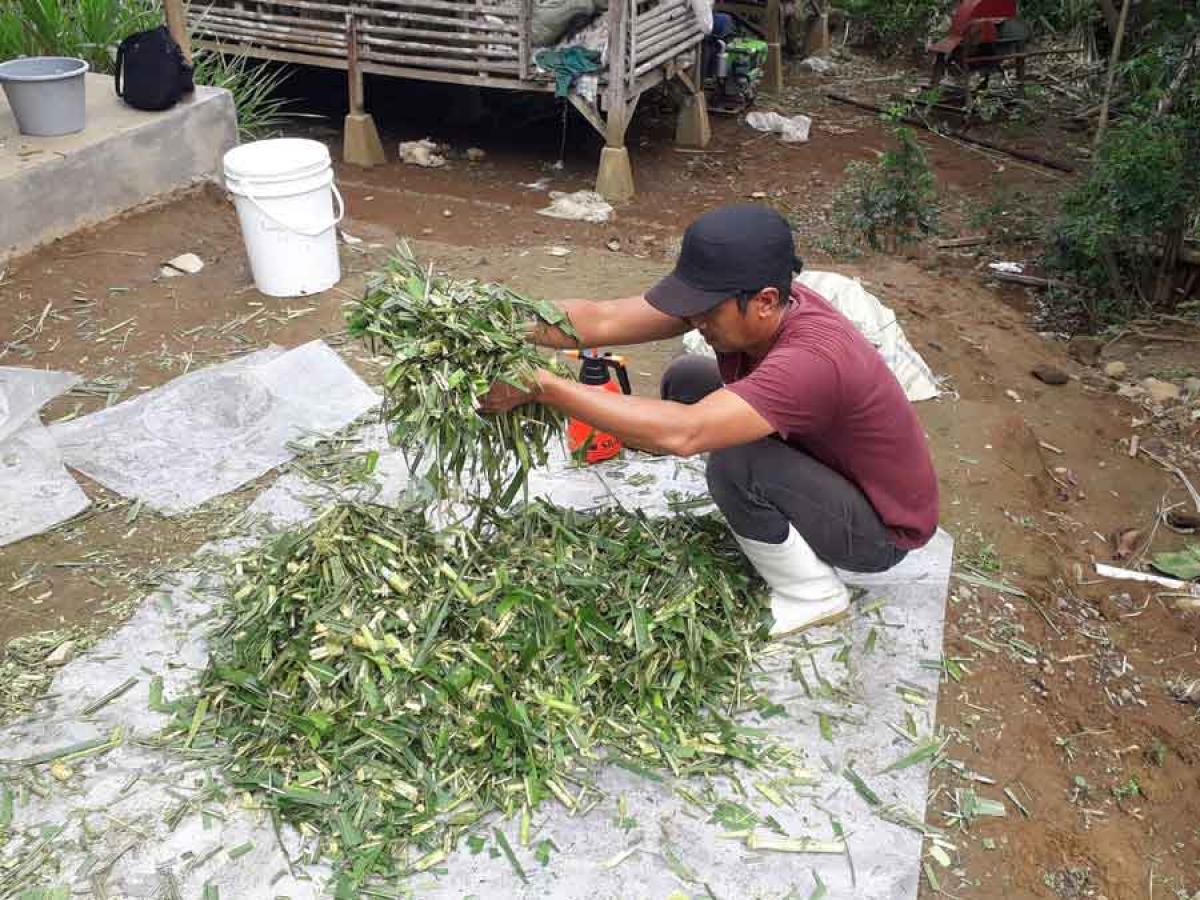
Pak Ma'mur making elephant grass silage by mixing molasses and incoculant through the chopped forage.
One week later Pak Ma'mur trialled making extra silage using elephant grass with a longer drying time to compare quality with the biograss silage. Silage is a method to conserve forage during the rainy season, to feed during times of feed shortages in the dry season. If made correctly the fermentation process converts the sugars into acids allowing it to be stored for periods of time until it is ready to be fed out. An inoculant, containing Lacobacillus bacteria also helps in the fermentation process and results in a high quality feed which is palatable for the cows to eat. The quality of the silage will be discussed at the last Focus Farm meeting in March.
Update - April 2020.
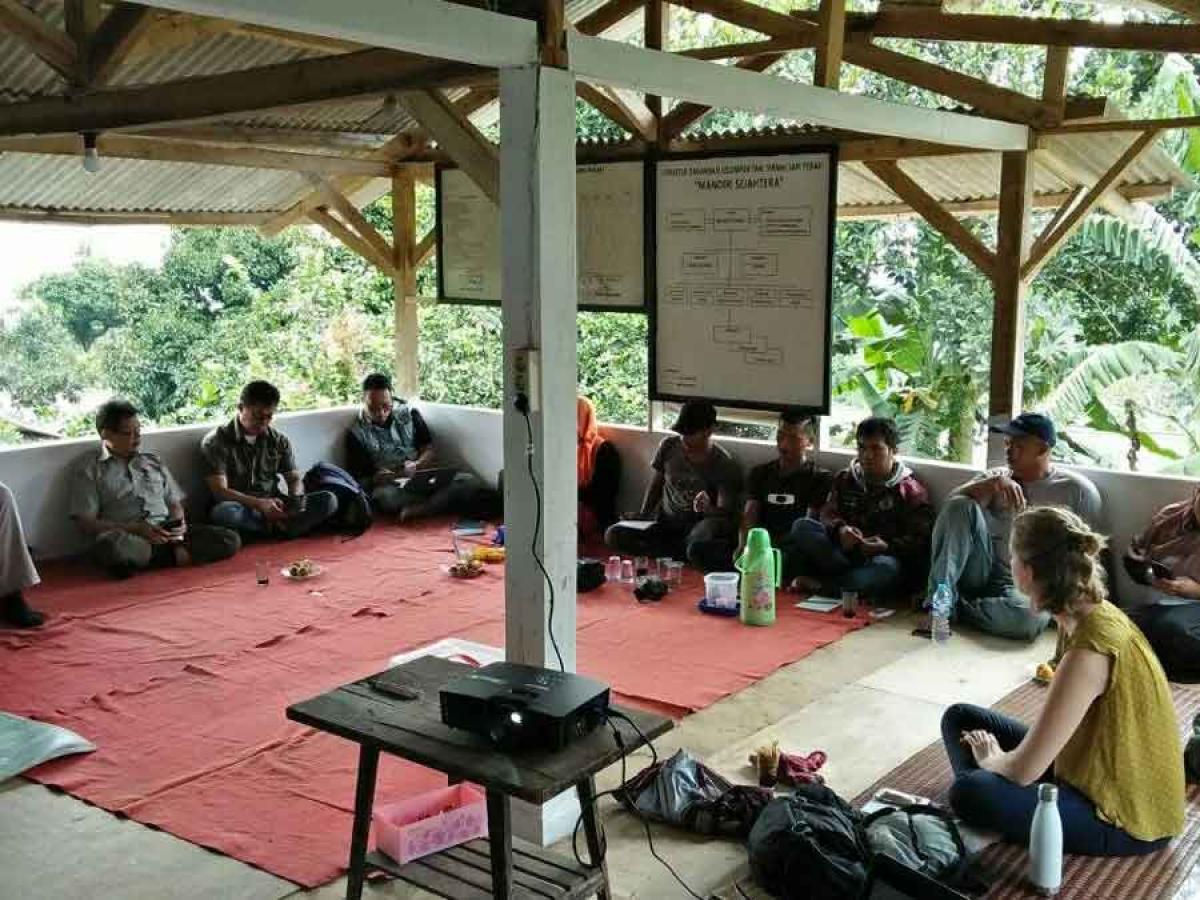
The last Focus Farm meeting at Pak Ma'mur's farm with the advisory group of farmers and advisors.
The sixth and final focus farm meeting was held at Pak Ma'mur's farm on 2 March 2020. This meeting discussed the results of previous meetings, as well as an evaluation from participants to collect their experiences after being involved in the Focus Farm.
One of the main activities on the Focus Farm was trialling some new forages to help improve feed availability and also the quality. Forages trialled included biograss grass (an improved variety of elephant grass), as well as elephant grass which were also given urea treatments and observed. Biograss grass and elephant grass were analysed after 91 days of growth since planting the cuttings in October. Leaf samples were taken, dried and analysed for protein and Neutral Detergent Fibre (NDF).
| The forage samples | Protein % | NDF % |
|---|---|---|
| Biograss grass | 17.95 | 61.79 |
| Elephant grass | 15.38 | 63.15 |
Table 1. The results of forage sampled analysed on the trial block at 91 days of growth.
During the meetings, Pak Ma'mur raised some issues relating to animal health as he had a couple of cows that aborted pregnancy, and more recently a cow was very weak after calving, producing a low volume of colostrum. Metabolic disorders were discussed as a possible cause and also to consider blood tests to check for any viral or bacterial infections. There had been a case of brucellosis in the past but he was able to rule this out as a possible cause through a blood test.
After a diet analysis the crude protein of the diet was low at approximately 13.5% so soybean meal and molasses was introduced for 21 days for six cows as a trial. Pak Ma'mur explained,
"soybean meal and molasses showed to increase milk production across the six cows but the best response was seen in the early lactation cows. This helped me to pay more attention to the cows in the early lactation with an opportunity to feed them the better quality feed available".
| Month | Total milk production (litres) | Number of lactating cows | Litres / cow / day | Total income / L | Milk income / L | Cost of production / litre (Rp/L) | Net profit / L (Rp) |
|---|---|---|---|---|---|---|---|
| July | 4,396 | 21 | 10* | 4,630 | 4,296 | 2,909 | 1,721 |
| August | 5,409 | 17 | 10 | 75 | 4,526 | 3,131 | 4,195 |
| September | 4,814 | 17 | 9 | 7,596 | 3,528 | 2,496 | 5,104 |
| October | 4,868 | 15 | 10 | 8,985 | 5,698 | 5,783 | 3,202 |
| November | 4,037.5 | 12 | 11 | 5,734 | 5,7734 | 7,255 | -1,521 |
| December | 3,817 | 12 | 10 | 8,692 | 5,484 | 6,332 | 2,360 |
| January | 3,874 | 12 | 10 | 5,484 | 5,484 | 8,166 | -2,683 |
| February | 3,831 | 11 | 10 | 12,672 | 5,492 | 7,979 | 4,692 |
| Average | 3,939 | 15 | 10 | 6,734 | 4,211 | 4,397 | 2,337 |
*To note the month of July only had 21 days of data collected
**No inputed labour costs or depreciation are considered in this analysis
Table 2. Farm Business Analysis Summary from July 2019 - February 2020.
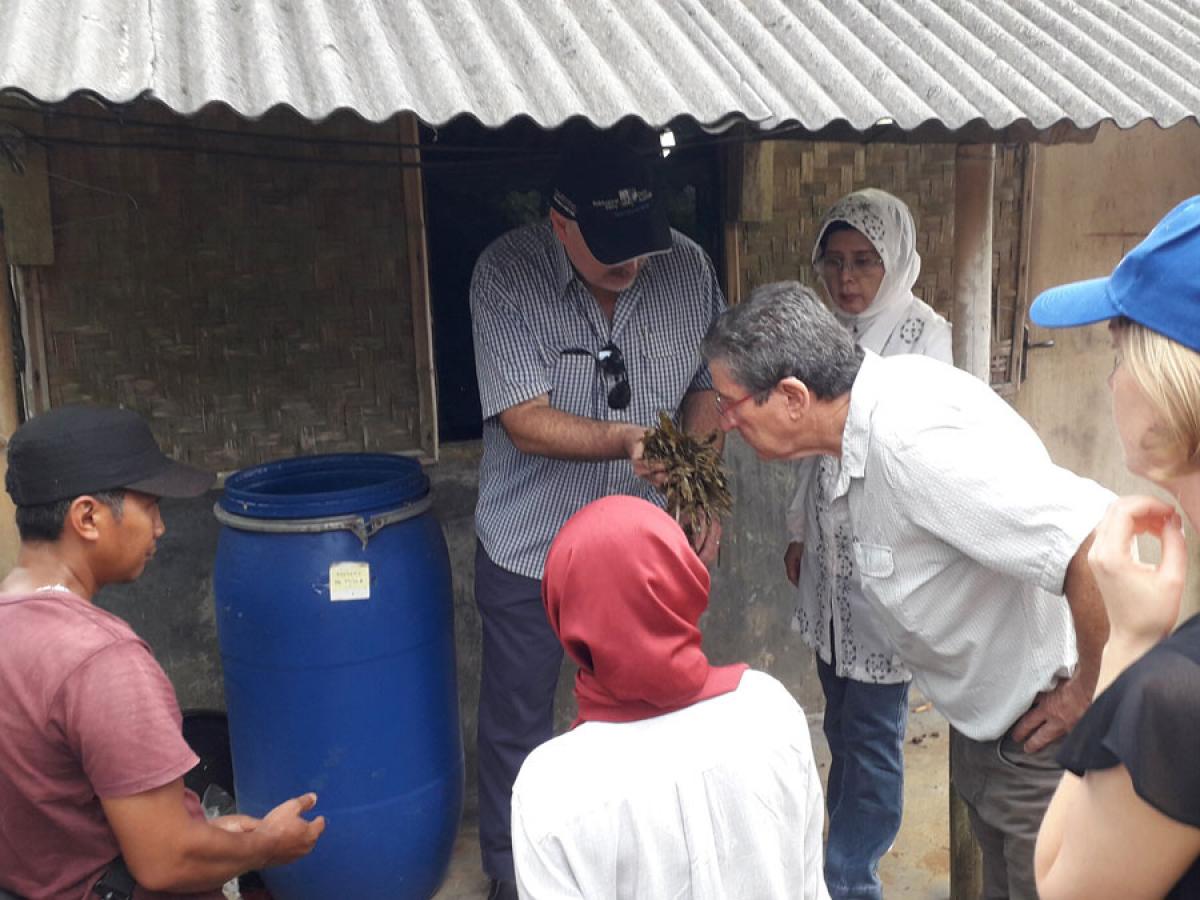
A visit from Howard Hall from ACIAR with Dr Brad Granzin inspecting the silage after opening.
Farm income (milk and livestock sales) and farm costs were recorded monthly from July 2019 – February 2020 to calculate profit per month. Over this period the average profit was 2,337 Rp/L. On the farm, sales from livestock was a large driver of farm income and profit, and Pak Ma'mur has a keen interest to continue to improve profitability of milk production into the future. The recording activities during the Focus Farm have helped to keep track of expenses incurred and income from the different sources.
Silage was trialled using the biograss and elephant grass. For the biograss:
- 60-70 kg biograss grass was harvested in the morning (85 days after the forage planting), then chopped by the machine and ensiled with molasses and an inoculant (probiotic mix called BIORESIK)
- A solution of 3 kg molasses, 200 ml of probiotics and 1.5 litres of water was sprayed evenly and mixed through the silage and packed down in the drum and sealed for 21 days.
The first batch of silage production was quite wet due to rainy conditions. To overcome the higher water content it was recommended to put some concentrates in the bottom to absorb the water and cover the top with salt to reduce the decay from air in the top of the drum.
Smaller drums of elephant grass were also trialled with a longer drying time. At the time of opening, the silage from one of the smaller drums was mouldy due to the presence of air because the silage was not packed tight enough and sealed. Each bucket of silage was sampled and had lower protein levels compared to the odot silage at Pak Yunus's farm (about 14%CP). This is because the biograss and elephant grass had more stem ensiled which is of lower quality. The levels of the volatile acids were above recommended levels for most samples, with some at acceptable levels. However, further analyses would be needed to be conclusive.
| Forage sample | Protein % | NDF % | VFA % results against target | ||
|---|---|---|---|---|---|
| Acetate <3 | Propionate <0.1 | Butyrate <0.5 | |||
| Biograss silage (1) (7 hours fried) | 10.88 | 49.12 | 5.04 | 1.37 | 0.91 |
| Biograss silage (2) (3 days dried) | 10.42 | 54.66 | 4.53 | 0.65 | 0.34 |
| Elephant grass silage (1) (3 days dried) | 11.19 | 55.81 | 5.47 | 1.03 | 0.61 |
| Elephant grass silage (2) (2 days dried) | 10.01 | 55.07 | 4.95 | 0.66 | 0.45 |
Table 3. Analysis of the silage results for Pak Ma'mur.
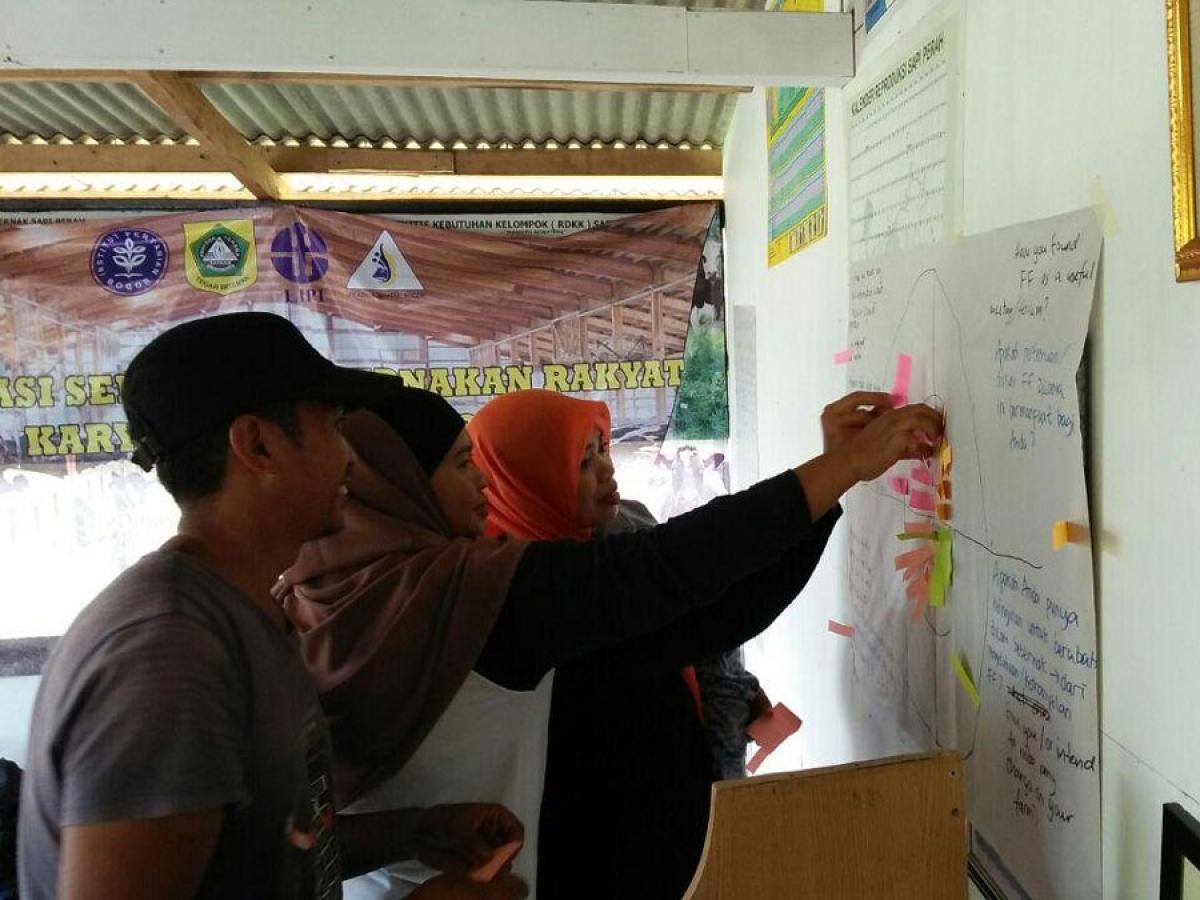
Pak Ma'mur, Ibu Eneng (wife of Pak Ma'mur) and support farmer Ibu Martini pasting the sticker dot using the dartboard evaluation method of the Focus Farm.
In future, it is recommended that drums containing 160 kg of forage should be mixed with 5 litres of molasses, 2.5 litres of water and 0.5 litres inoculant, and chopped and packed very tight to remove all the air for suitable fermentation to occur.
After being involved in the Focus Farm over six meetings, Pak Ma'mur said,
"From the Focus Farm, I have learned a lot about forage management and gained a lot of information about the condition of my cows. I've also gained new relationships and a lot of new knowledge about my business analysis, quality of milk, and also managing the land using soil tests, compost and trialling new types of grass such as biograss which I now know about and its nutritional value. Thank you IndoDairy for allowing me to learn a lot during this Focus Farm activity and the team for their support.”
